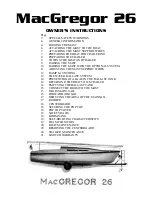
44
44
Helm Control Systems
The controls have a single lever for the engine
that operates as a gearshift and a throttle. Gen-
eral operation will include a position for neutral
(straight up and down or slightly aft of vertical),
a forward position (the 1st detent forward of neu-
tral) and a reverse position (the 1st detent aft of
neutral). Advancing the control lever beyond the
shift range advances the throttle in forward or
reverse. Each control is equipped with a means of
permitting the engine to be operated at a higher
than idle RPM while in neutral for cold starting and
warm-up purposes. The control lever is equipped
with an adjustable control head detent and fric-
tion settings.
The engine control and key pad has integrated
switches and indicator lights which allow the op-
erator to control all aspects of the boat’s propul-
sion system. LED lights on the control indicate
that the control is activated and the engine can
be started.
The most common features activated or
monitored by the keypad are:
• Starter lockout, which prevents the engine
from being started in gear.
• Gear lockout, which allows the engine RPM to
be advanced in neutral safely.
• Battery voltage warning indicator that warns
the operator of high or low voltage supplied
to the system (audible alarm).
• Trolling feature that allows the operator
to increase the engine speed in 50 RPM
increments while operating at trolling speeds
between 600 - 1000 RPM.
These features and others not mentioned require
specific procedures to activate and operate them
properly. Some of the procedures and features are
unique to the engine and other options installed on
your boat. It is essential that you read the owner’s
manual for the controls and be completely familiar
with their operation before using your boat.
CAUTION
ALWAYS RETURN THE ENGINE THROTTLE LEVER TO THE
EXTREME LOW SPEED POSITION BEFORE SHIFTING. NEVER
SHIFT THE UNIT WHILE ENGINE SPEED IS ABOVE IDLE RPM.
4.3 Neutral Safety Switch
Every control system has a neutral safety switch
incorporated into it. This device prohibits the
engine from being started while the shift lever is
in any position other than the neutral position. If
the engine will not start, slight movement of the
shift lever may be necessary to locate the neutral
position and disengage the safety cutout switch.
Control or cable adjustments may be required to
correct this condition should it persist. See your
Everglades dealer for necessary control and/or
cable adjustments.
The neutral safety switch should be tested pe-
riodically to ensure that it is operating properly.
To test the neutral safety switch, make sure the
engine is tilted down and move the shift lever to
the forward position. Make sure the control lever
is not advanced past the idle position. Turn the
ignition key to the start position just long enough
to briefly engage the starter for the engine. Do not
hold the key in the start position long enough to
start the engine. The starter should not engage.
Repeat this test with the shift lever in reverse
and the engine throttle at idle. Again, the starter
should not engage. If the starter engages with
the shift control in any position other than the
neutral position, then the neutral safety switch is
not functioning properly and you should contact
your dealer and have the neutral safety switch
repaired before using your boat. If the engine
starts in gear during this test, immediately move
the control lever to the neutral position.
CAUTION
IN SOME SITUATIONS, IT MAY BE POSSIBLE TO ACCIDENTALLY
START THE ENGINE IN GEAR WITH THE THROTTLE ABOVE
IDLE IF THE NEUTRAL SAFETY SWITCH IS NOT OPERATING
PROPERLY. THIS WOULD CAUSE THE BOAT TO ACCELERATE
UNEXPECTEDLY IN FORWARD OR REVERSE AND COULD
RESULT IN LOSS OF CONTROL, DAMAGE TO THE BOAT OR
INJURY TO PASSENGERS. ALWAYS TEST THE NEUTRAL
SAFETY SWITCH PERIODICALLY AND CORRECT ANY
PROBLEMS BEFORE USING THE BOAT.
Summary of Contents for 230 DC 2012
Page 1: ...OWNER S MANUAL 2012 230 DC ...
Page 2: ...2 Revision 1 2 15 2012 STILL NEED WIRE SCHEMATIC ...
Page 6: ...6 TABLE OF CONTENTS Appendix E FLOAT PLAN 121 Appendix F TROUBLESHOOTING GUIDE 123 ...
Page 10: ...10 THIS PAGE WAS LEFT BLANK INTENTIONALLY ...
Page 12: ...12 THIS PAGE WAS LEFT BLANK INTENTIONALLY ...
Page 16: ...16 THIS PAGE WAS LEFT BLANK INTENTIONALLY ...
Page 22: ...22 THIS PAGE WAS LEFT BLANK INTENTIONALLY ...
Page 25: ...25 Operation ...
Page 36: ...36 THIS PAGE WAS LEFT BLANK INTENTIONALLY ...
Page 50: ...50 THIS PAGE WAS LEFT BLANK INTENTIONALLY ...
Page 64: ...64 THIS PAGE WAS LEFT BLANK INTENTIONALLY ...
Page 98: ...98 THIS PAGE WAS LEFT BLANK INTENTIONALLY ...
Page 104: ...104 THIS PAGE WAS LEFT BLANK INTENTIONALLY ...
Page 105: ...105 SCHEMATICS Appendix A ...
Page 106: ...106 ...
Page 111: ...111 MAINTENANCE LOG Appendix C Hours Date Dealer Service Repairs ...
Page 112: ...112 Maintenance Schedule and Log MAINTENANCE LOG Hours Date Dealer Service Repairs ...
Page 113: ...113 Maintenance Schedule and Log MAINTENANCE LOG Hours Date Dealer Service Repairs ...
Page 114: ...114 Maintenance Schedule and Log MAINTENANCE LOG Hours Date Dealer Service Repairs ...
Page 115: ...115 Maintenance Schedule and Log MAINTENANCE LOG Hours Date Dealer Service Repairs ...
Page 116: ...116 Maintenance Schedule and Log MAINTENANCE LOG Hours Date Dealer Service Repairs ...
Page 117: ...117 Appendix D BOATING ACCIDENT REPORT ...
Page 118: ...118 Boating Accident Report ...
Page 119: ...119 Boating Accident Report ...
Page 120: ...120 THIS PAGE WAS LEFT BLANK INTENTIONALLY ...
Page 122: ...122 THIS PAGE WAS LEFT BLANK INTENTIONALLY ...
Page 127: ...CAUSE AND SOLUTION ...
Page 128: ...Everglades Boats 544 Air Park Road Edgewater Florida 32132 ...
















































